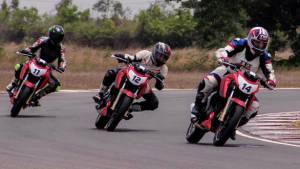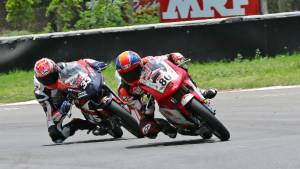What fear means to the motorcycle racer. . .
"Faster, faster, faster, until the thrill of speed overcomes the fear of death."
-Hunter S Thompson
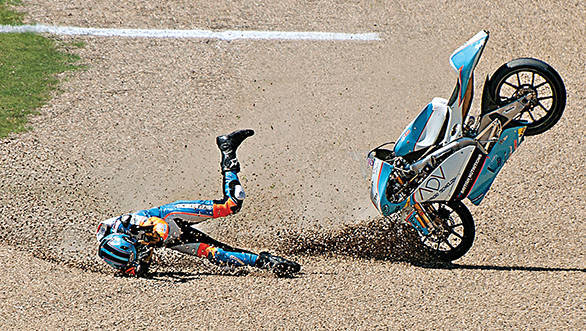
As I'm sitting down to type this story, my palms are sweating a little. My heart is racing a wee bit. And I'm feeling, for all intents and purposes, a little worse for the wear. As research material for this story, other than talking to several men who wring the throttle as a way of life, I was, in a moment of weakness, lured by the temptation that is the Internet and found myself watching a five minute compilation of British Superbike's worst crashes ever.
The crashes are grizzly. And as the seconds tick away, I find myself wondering why I'm watching this video at all. But I'm staring unblinkingly at the screen. Watching riders high side, low side, crash into each other, lie prostrate on the racetrack as wheels pass inches from their helmets, be flung into and over Armco barriers, resulting in them very often looking like crumpled heaps of deflated riding leather. Astoundingly enough, these crumpled heaps of deflated riding leather, once in a while actually manage to get up and carry on riding. Sometimes though, they don't. And it's these times that are frightening. So, I quickly dismiss the possibility that the reason behind the physiological tells I am experiencing at the moment could be a sudden onset of malaria or ebola or consumption or some other equally worrying illness. The plain and simple truth is that I am afraid just watching these videos.
Which brings me to this question - what is fear? Well, the Cambridge Dictionary describes it thusly. "An unpleasant emotion or thought that you have when you are frightened or worried by something dangerous, painful or bad that is happening or might happen." Physiologically, it manifests itself when your sympathetic nervous system releases adrenaline and noradrenaline, all in a bid to ready the human body to either fight Scrappy Doo style or take flight much like Courage the Cowardly Dog. Extra oxygen is pumped to your arms and legs, which will be needed for said fight or flight, and the extra heat produced by all this oxygen results in one breaking out into a sweat. However, since the gastrointestinal system and the like isn't needed at that point, oxygen supply to these regions is cut off, the systems shut down, and these parts of the body get cold. Hence the term "cold sweats."
Naturally, seeing as we're all human, fear is something we all experience. It's just that while we appear to have this urge to either fight or take flight, from what I can understand, your average motorcycle racer doesn't - because for him, on the bike, it's all par for the course. Is the average motorcycle racer fearless, then? No, not entirely. And it's a downright reassuring fact.
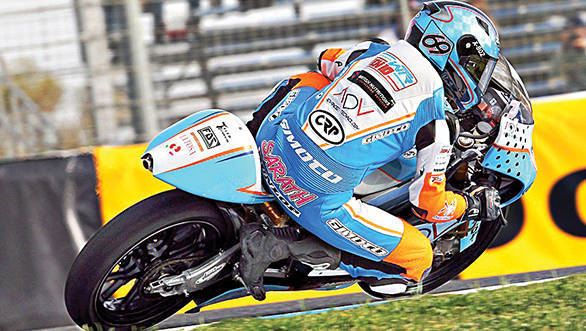 Sarath Kumar's Moto3 stint saw him come to terms with a very fast race machine. . .
Sarath Kumar's Moto3 stint saw him come to terms with a very fast race machine. . .
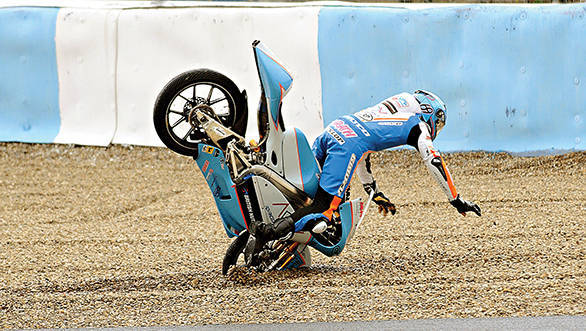 . . . It also saw him come to terms with some extremely high speed crashes. Crashes that he says he's managed to get past
. . . It also saw him come to terms with some extremely high speed crashes. Crashes that he says he's managed to get past
Sarath Kumar, easily India's biggest motorcycling hope in recent times, starts off by telling me how he believes every single motorcycle racer is afraid. Afraid, so long as the five red lights on the race track are on. Sarath says that while lined up on the grid, before the race starts, there are many things that go through a rider's mind. One of which is the anxiety and fear that he needs to perform well and win no matter what. There are also butterflies that are invariably doing wheel-of-death-esque stunts in a racer's stomach, he confesses. But the poor sods don't know what they've got coming, because once those five red lights go out and the throttle is pinned, they're gone for good. "When you're on the bike and the lights go out, your mental state changes. It's like the devil's in you. You just want to go faster, beat everyone and win," he says. Once in motion, there's simply no room for fear.
It's something that racecar drivers have also said to me in the past. But K Rajini, who's currently off to race in his fourth season of the Losail Asian Road Racing Championship, his second in the 1000cc class, says that the perspective you have on a motorcycle is, of course, manifestly different. Certainly, you can aim for the apex of a corner and tackle it very nicely in a racecar. But on a motorcycle, that friendly smiling corner, takes on a different face entirely, sneering at you menacingly. Perhaps it has something to do with the fact that you're leaned over, knees grazing the apex, hanging onto the bars, and looking at the world at an angle most people aren't used to. With your helmet literally inches off the ground, you're well and truly 'in' that corner. "On a motorcycle, you're practically on the ground in a corner. But you don't think about crashing. You just think about the next corner," Rajini says.
But being in the business of motorcycle racing means that slides and crashes and broken bones and injuries are all a part of a day at the office then. Rajini describes to me in rather a lot of detail, how his latest crash at Sepang has resulted in a finger with no skin left on it. But that's okay, he says. It's not as bad as his worst crash ever. China. On a cold track. With cold tyres. He only realised he'd had a crash eight hours after the event itself, when he woke up to the concerned faces of hospital staff. Something similar happened to Sarath too when he crashed his Mahindra Moto3 bike at Jerez and ended up being knocked unconscious for five hours. It was only when his mentor and coach Ramji Govindrajan repeatedly explained to him what had happened, that he was able to process that he'd had a crash. In fact it was only upon Ramji's repeated insistence that Sarath even grasped that they were in Spain at all!
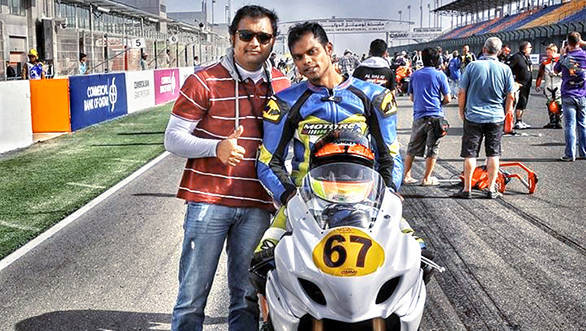 K Rajini says when you're on the motorcycle, leaned over into a corner, you're only thought is the next corner
K Rajini says when you're on the motorcycle, leaned over into a corner, you're only thought is the next corner
Between just these two, the crashes have been countless. The injuries endless. "My collar bone, my shoulder…" Sarath rattles off. "My thumbs, my fingers, an injury to my backbone that still hurts in the cold weather or with continuous riding…" Rajini goes on. So, surely, the injuries and surgeries and recovery time cause fear? "Of course they do," they both say. But, no, it isn't the sort of fear that you and I would imagine. Sarath says the fear is that he's missing a race, he's potentially losing out on points and a championship too. It's not a good feeling. Rajini says it's as good as your career being cut short - All races are a significant part of your racing career, and you need to ride in every single one of them to get better and reach your true potential. The injuries don't scare them. The time away from the racetrack does.
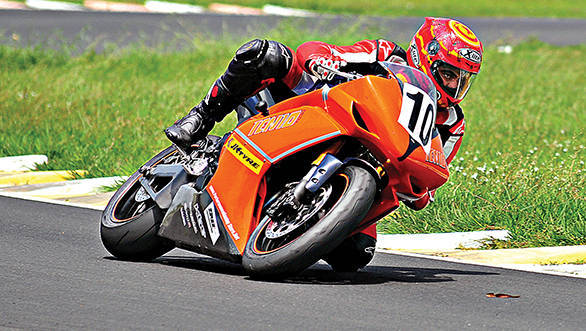 Ramji's own experience as a racer taught him that fear is something his generation didn't have, possibly because they didn't know any better!
Ramji's own experience as a racer taught him that fear is something his generation didn't have, possibly because they didn't know any better!
"I think as racers we accept that we will fall. We know we're going to get injured. And our immediate thought is that we must get back on the bike," Sarath says. Which is why he's trained himself to fall right. When he crashes, he says he always lets go. He just never hangs onto the bike, never tries to stop his body from sliding, just let's the momentum carry him forward until he comes to a natural halt. If you try anything else, you're almost certain to break something. Rajini talks of a time in Sepang in 2008 when he crashed on the main straight. While he was sliding along the tarmac, wheels whizzing by his helmet for what seemed like an eternity, he had one startlingly philosophical thought in his head for a time like that. "I began to think that somehow God was great because I didn't appear to be getting hurt at all."
Ramji, a racer in his own right back in the day, has today seen many a racer fall, get up, and get back on the bike. He's seen an equal number of novices fall, say goodbye to racing, and never make it back to the racetrack again. But from his experience with truly professional racers, Sarath included, he says he believes a rather universal definition of fear. It's only fear of the unknown that stops you or scares you. Like the two bad crashes that Sarath had at Imola and Jerez, both of which were caused by gusts of wind lifting the bike off the circuit. When you know what's gone wrong, or if you know that as a rider you made a mistake, it's easy to get over it. It's only a crash in an inexplicable circumstance that can scare you. That fear eventually goes away, he says, as it has for Sarath.
Ramji's own experiences with racing taught him that fear was something his generation didn't have, possibly because they didn't know any better. "We started racing on the roads, with helmets, but no riding kit." It was only later, when they shifted to the relative safety of the racetrack that they understood what they'd been doing had been admittedly foolish. Then with gradual knowledge of the set up of the bike, the knowledge that there were better tyres out there, the first crash that made you go faster, was there a retrospective fear of sorts. "Today, there's a lot more knowledge, a lot more safety, a lot more faith in riding kit, which is why I think the young racers aren't afraid," he says.
Oh, there are other fears. You break your bike, you pay for it. You ruin a helmet, you borrow money from a friend to pay for it. You ruin your riding leathers, egad, you need to cough up the dosh from somewhere to be able to afford a new pair ahead of your next race. "Things like that scare me," Rajini says. "I think riders who are fully sponsored don't have such fears," he continues.
Ramji's fears while racing were similar. After all, it was a clandestine activity that involved his motorcycle mysteriously being given for "service" every race weekend as far as his family was concerned. Instead, it was being prepped for an outing at the track. "If I crashed, I couldn't explain it to my Dad because he was under the impression that the bike was being serviced at the time!"
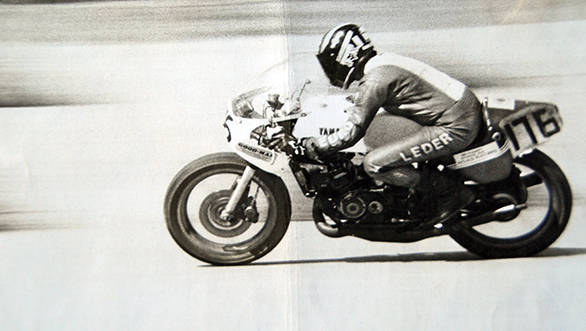 Somender Singh who raced in the 1970s and gathered many a trophy says that back in the day, there was always some fear there - the knowledge that you were racing on old tyres, the fact that a part of your race bike was being held together by some questionable welding
Somender Singh who raced in the 1970s and gathered many a trophy says that back in the day, there was always some fear there - the knowledge that you were racing on old tyres, the fact that a part of your race bike was being held together by some questionable welding
I've read somewhere that some racers don't like watching races because when you see it from the outside it is scary. Rajini says he spends all his spare time watching races, for it gives him ideas and tips and serves as a riding school in itself. Sarath says the odd crash does bother him though. "When I see a racer end up in a wheelchair or something, then at the back of my mind I just say that that's not something I'd like to have happen to me in my career." Fair enough.
Back in the day, between 1972 and 1986, Somender Singh was quite a name in the Indian motorcycling scene. He would take to the racetrack astride his Jawa 250 or on a Yamaha TZR and would blat past everything in sight. These many years later, he remembers that there was always some fear there - the knowledge that you were racing on old tyres, the fact that a part of your race bike was being held together by some questionable welding.
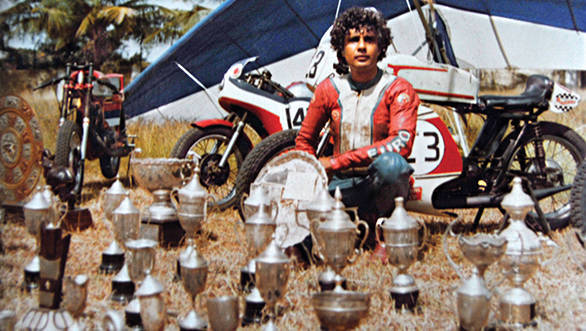 Here Singh is surrounded by trophies enough to prove that fear didn't really and truly get in his way
Here Singh is surrounded by trophies enough to prove that fear didn't really and truly get in his way
But there was enough speed and adrenaline to get you past it in any case. Crashes that you saw during a race would only serve to make you want to go faster and do better and push yourself to your limit. "I was always racing with myself, testing my own limits, a little like shadow boxing," he says. Pushing yourself to your own limits. Finding the limit. And knowing that there is no fear within these limits that sometimes defy logic and physics all at once - that seems to be how motorcycle racers operate, then.
So why do they go racing? Because they're racers. It's as simple as that. There's a deep desire that burns within them that every single time they get on the bike, they have to be the best, they have to beat the best, they have to win. The broken bones, torn leathers, the odd concussion - they really are par for the course. And yes, the fear too.
Also read:
What fear means to the Indian race car driver
.

